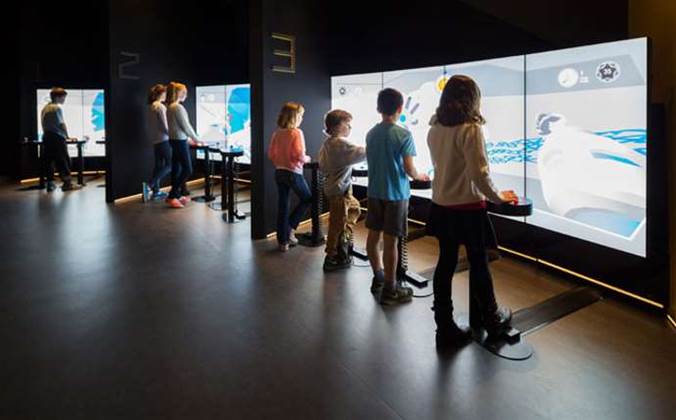The National Museum of Australia has opened its overhauled Kspace interactive exhibit, giving kids and schools the chance to take a 'virtual robot trip' through Australian history.

The original Kspace – now nicknamed Kspace 1.0 – was a digital experience that allowed children to examine the future possibilities of technology. The exhibit housed one LCD screen, 12 interactive touchscreens and a 3D theatre.
In 2012, 11 years after it first opened, a decision was made to redevelop the interactive gallery due to its increasing technical obsolesence.
Last month, for a final cost of around $2 million, the redeveloped Kspace opened its doors to the public, offering a new interactive exhibit that allows kids and families to design a robot and take it back in time.
The National Museum of Australia’s senior IT systems engineer Rick Ruthven and Kspace project manager Karina West told iTnews the exhibit needed to be fun enough for kids to want to return as well as educational.
“We wanted to create something to help families, school groups and kids to engage with Australian history. It had to be fun – if it was a didactic experience they wouldn’t come back," West said.
“At the same time, we wanted it to be educational, and give kids the chance to notice something – costumes or animals – they hadn’t seen before.”
Three-stage interactive learning environment
The new exhibit is built around an interactive adventure, through three physical spaces that allow kids to design a virtual robot, and then use it to explore one of eight scenes from Australian history.
“The first space you step into is the design stage, where you get to design a robot and put your face on it,” West said.
“Next, it’s time to go to the pod area, which is a physically separate area, where you’re taken at random to one of the eight [historical] scenes. They range from Australia 110 million years ago through to the Victorian goldfields, and each scene has a mission to complete.
“In the game, you use the robot you created in the first phase, and teams can combine their robots into what we call a ‘mech’. As use your robot to take photos and interact with objects, you get points and uncover the narrative.
“The third stage is called the cool-down area, where kids can find out more context about the scene they played. They can also send an electronic postcard of their tip that includes their robot and their score.”
The first space boasts four 55-inch multi-touch screens for each team, the second has four 55-inch screens controlled by arcade-style joysticks and buttons, and the final cool-down area contains three 55-inch touchscreens.
Afterwards, students can download an augmented reality app for iOS or Android where characters from the game guide them to relevant exhibits in the National Museum’s collection.
Purpose-built facility
Behind the scenes, staff have access to a control console that allows them to start and stop shows, change signage, send bulk electronic postcards for school groups and monitor security cameras.
“We have new hardware – new PCs with virtual servers as a backend. There’s new A/V equipment, and the PCs are now hidden out the back instead of sitting on the desks, as we did in [Kspace 1.0]” Ruthven said.
“Each pod is powered by one PC with four screens, plus we have one PC to keep them all in sync.
“We also have VMWare running across three physical Ubuntu servers, while the PCs run customised Windows 8.”
The three physical servers run the same software and constantly poll each other, with automatic failover. This means even if the hardware on one of the machines fails, Kspace can continue operating with no downtime.
Custom software
The main game experience and scenes were built using the Unity game engine, while interfaces are built in HTML5 with a Ruby on Rails backend.
“It was all custom developed. Spinifex was the lead developer, and they subcontracted the game development to a company called Well Placed Cactus,” West said.
“Then we had the National Museum project team do a lot of the content design, QA and testing.
“The testing process for the software at our end was fairly intensive, because while the developers did some testing, the setup we have here is not something that can be easily replicated.
“Kspace runs eight hours a day, seven days a week, so it needs to be robust."
The opening of the new facility marks the culmination of a three-year-long journey to replace Kspace 1.0, which was becoming dated after 11 years in action.
The increasing downtime was the result of obsolete hardware and software.
“The old environment was PC-based running on [Windows] XP machines, and as you can imagine, we were having trouble supporting video cards of that vintage,” Ruthven said.
All the hardware for the new Kspace needed to be robust enough to handle the rigorous of a classroom full of school children, while remaining online for eight hours a day, seven days a week.
The facility also needed to cater to children from a range of different age groups, as well as teachers and guardians.
“Our broad brief was that it had to be suitable for five to 12-year-olds. Now, anyone who has kids will tell you five-year-olds have very different expectations to 12-year-olds,” West said.
“We wanted to make it so a 12-year-old could find and collect more things to get more points, yet not make it so complex that a five-year old couldn’t play.”
The design also includes tablets for staff that can be used to adjust the height of the controllers so they can be used by young children, older children, or adults. This was done using actuators, which are typically used to adjust the height of standing desks.


.png&h=140&w=231&c=1&s=0)
_(20).jpg&h=140&w=231&c=1&s=0)
_(22).jpg&h=140&w=231&c=1&s=0)




_(26).jpg&w=100&c=1&s=0)

 iTnews Executive Retreat - Security Leaders Edition
iTnews Executive Retreat - Security Leaders Edition












_(1).jpg&h=140&w=231&c=1&s=0)



